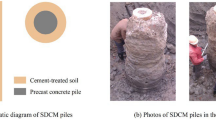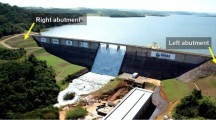Abstract
Clayey-silt aquitards account for 60 % of the ~100-m-thick alluvial sediment sequence in the Gunnedah area of eastern Australia. To better understand the stress-dependent hydraulic properties of these low-permeability units, oedometer test data presented for the first time in this study have been integrated with geotechnical centrifuge permeameter tests. Estimates of vertical pre-consolidation effective stress (\(\sigma_{\text{p}}^{'}\)), vertical in situ effective stress (\(\sigma_{\text{i}}^{'}\)), and over-consolidation ratio (OCR) were used to determine whether centrifugation stresses caused compression of core samples, and the degree to which vertical hydraulic conductivity (K v) assessments were representative of the core samples tested. Results suggest that minimally disturbed drill core from semi-consolidated sediments (e.g., alluvial, colluvial, and eolian deposits) evaluated in this study should have target centrifugation stress less than \(\sigma_{\text{p}}^{'}, \) where OCR < 1 and \(\sigma_{\text{i}}^{'}\) where OCR > 1 to avoid significant changes in hydraulic properties during plastic straining. The results also imply that the stress-dependent response of aquitards is critical to understand the sensitivity of groundwater resources in areas with multiple stakeholders such as mining, coal seam gas, and agriculture developments. Groundwater in alluvial sediments that is essential for irrigation, water supply, and base flows to rivers must be sufficiently disconnected from groundwater in coal seams that are depressurized for extraction of energy resources.











Similar content being viewed by others

References
Acworth RI, Timms WA, Kelly BFJ, McGeeney DE, Ralph TJ, Larkin ZT, Rau GC (2015) Late Cenozoic paleovalley fill sequence from the Southern Liverpool Plains, New South Wales—implications for groundwater resource evaluation. Aust J Earth Sci. doi:10.1080/08120099.2015.1086815
Acworth RI, Timms WA (2009) Evidence for connected water processes through smectite-dominated clays at Breeza, New South Wales. Aust J Earth Sci 56:81–96
Ali A, Merrick NP, Williams RM, Mampitiya D, d’Hautefeuille F, Sinclair P (2004) Land settlement due to groundwater pumping in the Lower Namoi Valley of NSW. In: Proceedings of 9th Murray Darling Basin Groundwater Workshop, Bendigo, Australia
Anderson MS, Acworth RI (2009) Stream-aquifer interactions in the Maules Creek catchment, Namoi Valley, NSW, Australia. Hydrogeol J 17:2005–2021
Arch J (1998) Clay barriers in landfills. In: Parker A, Rae JE (eds) Environmental interactions of clays: clays and the environment. Springer, Berlin
AS (2009a) Methods of testing soils for engineering purposes—soil classification tests—determination of the liquid limit of a soil. Standard method 1289.3.1.1, Australian Standards, Sydney
AS (2009b) Methods of testing soils for engineering purposes—soil classification tests—determination of the plastic limit of a soil. Standard method 1289.3.2.1, Australian Standards, Sydney
AS (2009c) Methods of testing soils for engineering purposes—soil classification tests—calculation of the plasticity index of a soil. Standard method 1289.3.3.1, Australian Standards, Sydney
AS (2008a) Methods of testing soils for engineering purposes—soil classification tests—Determination of the percent dispersion of a soil. Standard method 1289.3.8.2, Australian Standards, Sydney
AS (2008b) Methods of testing soils for engineering purposes—soil classification tests—determination of the linear shrinkage of a soil. Standard method 1289.3.4.1, Australian Standards, Sydney
AS (2006a) Methods of testing soils for engineering purposes—soil classification tests—determination of soil particle density of a soil. Standard method 1289.3.5.1, Australian Standards, Sydney
AS (2006b) Methods of testing soils for engineering purposes—soil classification tests—determination of Emerson class number of a soil. Standard method 1289.3.8.1, Australian Standards, Sydney
AS (2005) Methods of testing soils for engineering purposes—soil moisture content tests. Standard method 1289.2.1.1, Australian Standards, Sydney
AS (2004) Methods of testing soils for engineering purposes—soil compaction and density tests. Standard method 1289.5.3.2, Australian Standards, Sydney
AS (2003) Methods of testing soils for engineering purposes—soil classification tests—determination of the shrinkage index of a soil—shrink-swell index. Standard method 1289.7.1.1, Australian Standards, Sydney
AS (1999a) Sampling and preparation of soils—undisturbed samples. Standard method 1289.1.3.1, Australian Standards, Sydney
AS (1999b) Methods of testing soils for engineering purposes—soil strength and consolidation tests—determination of permeability of a soil—constant head method using a flexible wall permeameter. Standard method 1289.6.7.3, Australian Standards, Sydney
AS (1998) Methods of testing soils for engineering purposes—soil strength and consolidation tests—determination of the one-dimensional consolidation properties of soil. Standard method 1289.6.6.1, Australian Standards, Sydney
ASTM (2010) Standard test methods for measurement of hydraulic conductivity of unsaturated soils. D7664, West Conshohocken, PA
ASTM (2008) Standard test method for determining unsaturated and saturated hydraulic conductivity in porous media by steady-state centrifugation. D6527, West Conshohocken, PA
Badenhop AM, Timms WA (2012) Long-term salinity changes in an inland aquifer, NSW, Australia. In: Proceedings of 34th hydrology and water resources symposium, engineers Australia, Sydney, pp 43–51
Bense VF, van den Berg EH, van Balen RT (2003) Deformation mechanisms and hydraulic properties of fault zones in unconsolidated sediments; the Roer Valley Rift System, The Netherlands. Hydrogeol J 11:319–332
Bishop AW (1959) The principle of effect stress. Teknisk Ukeblad 106(39):859–863
Bouzalakos S, Timms WA, Rahman P, McGeeney D, Whelan M (2013) Geotechnical centrifuge permeameter for characterizing the hydraulic integrity of partially saturated confining strata for CSG operations. In: Proceedings of international mine water association (IMWA) Annual Conference, Colorado School of Mines, Golden, USA, pp 1193–1198
Casagrande A (1936) The determination of pre-consolidation load and its practical significance. In: Proceedings of 1st conference of soil mechanics and foundation engineering, Cambridge, MA, pp 60–64
CSIRO (2007) Water availability in the Namoi. In: A report to the Australian Government from the CSIRO Murray-Darling Basin sustainable yields project, CSIRO Land and Water, Canberra, ACT
Farley C (2011) Aquitards and groundwater sustainability: three-dimensional mapping of aquitard architecture. B.E. thesis (unpublished), University of New South Wales, Australia
Grisak GE, Cherry JA (1975) Hydrologic characteristics and response of fractured till and clay confining a shallow aquifer. Can Geotech J 12(1):23–43
Grozic JLH, Lunne T, Pande S (2003) An oedometer test study on the pre-consolidation stress of glaciomarine clays. Can Geotech J 40(5):857–872
Head KH (1994) Manual of soil laboratory testing (vol 2): permeability, shear strength and compressibility tests. Halsted Press/Wiley, New York
Holtz RD, Kovacs WD (1981) An introduction to geotechnical engineering. Prentice-Hall, Upper Saddle River
Josh M, Esteban L, Delle Piane C, Sarout J, Dewhurst DN, Clenell MB (2012) Laboratory characterization of shale properties. J Pet Sci Eng 88–89:107–124
Kelly BFJ, Merrick N, Dent B, Milner-Home W, Yates D (2007) A scoping study on groundwater knowledge and gaps in the Namoi Catchment management area. In: A report for the Cotton Catchment Communities CRC, University of Technology, Sydney—National Centre for Groundwater Management Report, NCGM 2007/1
Kelly BFJ, Timms WA, Andersen MS, McCallum AM, Blakers RS, Smith R, Rau GC, Badenhop A, Ludowici K, Acworth RI (2013) Aquifer heterogeneity and response time: the challenge for groundwater management. Crop Pasture Sci 64:1141–1154
Kelly BFJ, Timms W, Ralph TJ, Giambastiani BMS, Comunian A, McCallum AM, Andersen MS, Blakers RS, Acworth RI, Baker A (2014) A reassessment of the Lower Namoi Catchment aquifer architecture and hydraulic connectivity with reference to climate drivers. Aust J Earth Sci. doi:10.1080/08120099.2014.900647
Kitajima H, Chester FM, Biscontin G (2012) Mechanical and hydraulic properties of Nankai accretionary prism sediments: effect of stress path. Geochem Geophys Geosyst 13:1–24
Lambe TW (1951) Soil testing for engineers. Wiley, New York
Lee J, Fox P (2005) Efficiency of seepage consolidation for preparation of clay substrate for centrifuge testing. Geotech Test J 28(6):1–9
Li Y-C, Cleall PJ (2013) Consolidation of sensitive clays: a numerical investigation. Acta Geotech 8(1):59–66
Loáiciga HA (2013) Consolidation settlement in aquifers caused by pumping. J Geotech Geoenviron Eng 139(7):1191–1204
Mesri G, Olson RE (1971) Mechanisms controlling the permeability of clays. Clay Clay Miner 19:151–158
Mortimer L, Aydin A, Simmons CT, Love AJ (2011) Is in situ stress important to groundwater flow in shallow fractured rock aquifers? J Hydrol 339(3–4):185–200
Neuzil CE (1986) Groundwater flow in low-permeability environments. Water Resour Res 22(8):1163–1195
Neuzil CE (1994) How permeable are clays and shales? Water Resour Res 30(2):145–150
Olson RE, Mesri G (1970) Mechanisms controlling the compressibility of clays. J Am Soc Civ Eng 96(SM6):1853–1878
Onitsuka K, Hong Z, Hara Y, Yoshitake S (1995) Interpretation of oedometer test data for natural clays. Soil Found 35(3):61–70
O’Regan M, Moran K (2007) Compressibility, permeability and stress history of sediments from Demerara Rise. In: Mosher DC, Erbacher J, Malone MJ (eds) Proceedings of the ODP, Science Results, 207: College Station, TX (Ocean Drilling Program), pp 1–35. doi:10.2973/odp.proc.sr.207.114.2007
Parks J, Stewart M, McCartney JS (2012) Validation of a centrifuge permeameter for investigation of transient infiltration and drainage flow processes in unsaturated soils. Geotech Test J 35(1):182–192
Ross J, Jeffery L (1991) Ground subsidence and bore collapse associated with groundwater withdrawals—Namoi Valley NSW. New South Wales (NSW) Department of Water Resources, Technical Services Division, Report Number TS91.007
Sauer EK, Christiansen EA (1991) Pre-consolidation pressures in the Battleford Formation, southern Saskatchewan, Canada. Can J Earth Sci 28:1613–1623
Schlumberger Water Services (2012) Namoi Catchment water study: independent expert, Final Study Report. In: 50371/P4-R2 FINAL, July 2012, Prepared for: Department of Trade and Investment, Regional Infrastructure and Services, New South Wales (DTIRIS NSW), Australia
Sims JE, Elsworth D, Cherry JA (1996) Stress-dependent flow through fractured clay till: a laboratory study. Can Geotech J 33:449–457
Skempton AW (1960) Effective stress in soils, concrete and rocks. In: Proceedings of pore pressure and suction in soils, Butterworths, London, pp 4–16
Smith LA, van der Kamp G, Hendry MJ (2013) A new technique for obtaining high-resolution pore pressure records in thick claystone aquitards and its use to determine in situ compressibility. Water Resour Res 49:732–743
Tadros NZ (1993) Memoir geology 12: the Gunnedah Basin, New South Wales. Geological Survey of New South Wales, Australia
Taylor DW (1948) Fundamentals of soil mechanics. Wiley, New York
Terzaghi K (1943) Theoretical soil mechanics. Wiley, New York
Terzaghi K, Peck RB (1967) Soil mechanics in engineering practice. Wiley, New York
Timms WA, Acworth RI (2005) Propagation of pressure change through thick clay sequences: an example from Liverpool Plains, NSW, Australia. Hydrogeol J 13:858–870
Timms WA, Hendry MJ (2008) Long term reactive solute transport in an aquitard using a centrifuge model. Ground Water 46:616–628
Timms WA, Crane R, Anderson DJ, Bouzalakos S, Whelan M, McGeeney D, Rahman PF, Guinea A, Acworth RI (2016) Accelerated gravity testing of aquitard core permeability and implications at formation and regional scale. Hydrol Earth Syst Sci 20(1):39–54
Timms WA, Whelan M, Acworth I, McGeeney D, Bouzalakos S, Crane R, McCartney J, Hartland A (2014) A novel centrifuge permeameter to characterize flow through low permeability strata. In: Proceedings of the international congress on physical modelling in geotechnics (ICPMG), Perth, Australia, pp 193–199
van der Kamp G (2001) Methods for determining the in situ hydraulic conductivity of shallow aquitards—an overview. Hydrogeol J 9:5–16
Waltham AC (1994) Foundations of engineering geology. E & FN Spon, Oxford
Wang GY, You G, Shi B, Yu J, Tuck M (2009) Long-term land subsidence and strata compression in Changzhou, China. Eng Geol 104:109–118
Zornberg JG, McCartney JS (2010) Centrifuge permeameter for unsaturated soils. I: theoretical basis and experimental developments. J Geotech Geoenviron Eng 136(8):1051–1063
Acknowledgments
Funding from the Australian Research Council and National Water Commission, through the National Centre for Groundwater Research and Training Program 1B, is gratefully acknowledged. Clayey-silt cores were drilled by New South Wales Office of Water, with S. McCulloch, H. Studhome, and G. Regmi. Experimental testing was assisted at UNSW by B. Bambrook, M. Aikins, and Y. Zhong. Technical support by M. Whelan and K. Gamage from UNSW School of Mining Engineering is appreciated.
Author information
Authors and Affiliations
Corresponding author
Rights and permissions
About this article
Cite this article
Bouzalakos, S., Crane, R.A., McGeeney, D. et al. Stress-dependent hydraulic properties of clayey-silt aquitards in eastern Australia. Acta Geotech. 11, 969–986 (2016). https://doi.org/10.1007/s11440-016-0455-7
Received:
Accepted:
Published:
Issue Date:
DOI: https://doi.org/10.1007/s11440-016-0455-7



